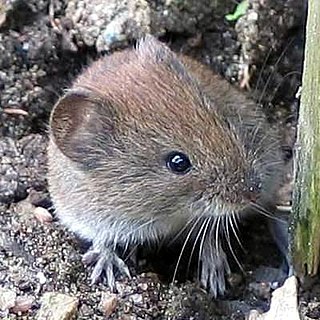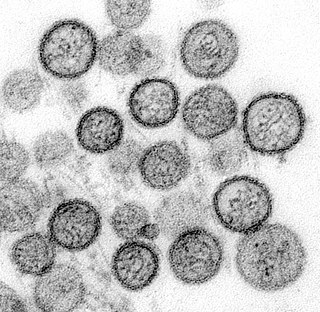
Orthohantavirus is a genus of single-stranded, enveloped, negative-sense RNA viruses in the family Hantaviridae within the order Bunyavirales. Members of this genus may be called orthohantaviruses or simply hantaviruses.

Sin Nombre orthohantavirus (SNV), a member of the genus Orthohantavirus, is the prototypical etiologic agent of hantavirus cardiopulmonary syndrome (HCPS).

Bunyavirales is an order of segmented negative-strand RNA viruses with mainly tripartite genomes. Member viruses infect arthropods, plants, protozoans, and vertebrates. It is the only order in the class Ellioviricetes. The name Bunyavirales derives from Bunyamwera, where the original type species Bunyamwera orthobunyavirus was first discovered. Ellioviricetes is named in honor of late virologist Richard M. Elliott for his early work on bunyaviruses.

The bank vole is a small vole with red-brown fur and some grey patches, with a tail about half as long as its body. A rodent, it lives in woodland areas and is around 100 millimetres (3.9 in) in length. The bank vole is found in much of Europe and in northwestern Asia. It is native to Great Britain but not to Ireland, where it has been accidentally introduced, and has now colonised much of the south and southwest.
Seoul orthohantavirus (SEOV) is a member of the genus Orthohantavirus of rodent-borne viruses, and is one of the four hantaviruses that are known to cause Hantavirus hemorrhagic fever with renal syndrome (HFRS). It is an Old World hantavirus; a negative sense, single-stranded, tri-segmented RNA virus.

Andes orthohantavirus (ANDV), a species of Orthohantavirus, is a major causative agent of hantavirus cardiopulmonary syndrome (HCPS) and hantavirus pulmonary syndrome (HPS) in South America. It is named for the Andes mountains of Chile and Argentina, where it was first discovered. Originating in the reservoir of rodents, Andes orthohantavirus is easily transmitted to humans who come into contact with infected rodents or their fecal droppings. However, infected rodents do not appear ill, so there is no readily apparent indicator to determine whether the rodent is infected or not. Additionally, Andes orthohantavirus, specifically, is the only hantavirus that can be spread by human to human contact via bodily fluids or long-term contact from one infected individual to a healthy person.
Sangassou orthohantavirus(SANGV) is single-stranded, negative-sense RNA virus species of the genus Orthohantavirus in the Bunyavirales order. It was first isolated in an African wood mouse (Hylomyscus simus) in the forest in Guinea, West Africa in 2010. It is named for the village near where the mouse was trapped. It is the first indigenous Murinae-associated African hantavirus to be discovered.

Hantavirus hemorrhagic fever with renal syndrome (HFRS) is a group of clinically similar illnesses caused by species of hantaviruses. It is also known as Korean hemorrhagic fever and epidemic hemorrhagic fever. It is found in Europe, Asia, and Africa. The species that cause HFRS include Hantaan orthohantavirus, Dobrava-Belgrade orthohantavirus, Saaremaa virus, Seoul orthohantavirus, Puumala orthohantavirus and other orthohantaviruses. Of these species, Hantaan River virus and Dobrava-Belgrade virus cause the most severe form of the syndrome and have the highest morbidity rates. When caused by the Puumala virus, it is also called nephropathia epidemica. This infection is known as sorkfeber in Swedish, myyräkuume in Finnish, and musepest in Norwegian.

Hantavirus pulmonary syndrome (HPS) is one of two potentially fatal syndromes of zoonotic origin caused by species of hantavirus. These include Black Creek Canal virus (BCCV), New York orthohantavirus (NYV), Monongahela virus (MGLV), Sin Nombre orthohantavirus (SNV), and certain other members of hantavirus genera that are native to the United States and Canada.
Dobrava-Belgrade orthohantavirus (DOBV), also known as Dobrava virus, is an enveloped, single-stranded, negative-sense RNA virus species of Old World Orthohantavirus. It is one of several species of Hantavirus that is the causative agent of severe Hantavirus hemorrhagic fever with renal syndrome. It was first isolated in 1985 from a yellow-necked mouse found in the village of Dobrava, southeastern Slovenia. It was subsequently isolated in striped field mice in Russia and other parts of Eastern Europe. It has also been found in Germany but the reservoir host there is unknown.
Soochong virus (SOOV) is a zoonotic negative sense single-stranded RNA virus. It may be a member of the genus Orthohantavirus, but it has not be definitively classified as a species and may only be a strain. It is one of four rodent-borne Hantaviruses found in the Republic of Korea. It is the etiologic agent for Hantavirus hemorrhagic fever with renal syndrome (HFRS). The other species responsible for HFRS in Korea are Seoul virus, Haantan virus, and Muju virus.
Muju virus(MUV) is a zoonotic negative-sense single-stranded RNA virus of the genus Orthohantavirus. It is a member virus of Puumala orthohantavirus. It is one of four rodent-borne Hantaviruses found in the Republic of Korea. It is the etiologic agent for Hantavirus hemorrhagic fever with renal syndrome (HFRS). The other species responsible for HFRS in Korea are Seoul orthohantavirus, Hantaan orthohantavirus, and Soochong virus.
Monongahela virus (MGLV) is a single-stranded, negative-sense Orthohantavirus virus of zoonotic origin that causes hantavirus pulmonary syndrome.
Hantaan orthohantavirus (HTNV) is an enveloped, single-stranded, negative-sense RNA virus species of Old World Orthohantavirus. It is the causative agent of Korean hemorrhagic fever in humans. It is named for the Hantan River in South Korea, and in turn lends the name to its genus Orthohantavirus and family Hantaviridae.
Topografov virus is an enveloped, negative-sense RNA virus of the genus Orthohantavirus in the Bunyavirales order. It is the first hantavirus to be isolated from Siberian lemmings found near the Topografov River in the Taymyr Peninsula, Siberia.
Choclo orthohantavirus (CHOV) is a single-stranded, negative-sense RNA zoonotic New World hantavirus. It was first isolated in 1999 in western Panama. The finding marked the first time Hantavirus pulmonary syndrome (HPS) was found in Central America.
Rockport virus (RKPV) is a single-stranded, enveloped, negative-sense RNA orthohantavirus.
Thailand virus (THAIV) is a single-stranded, enveloped, negative-sense RNA orthohantavirus.
Gou virus (GOUV) is a single-stranded, negative-sense, enveloped novel RNA orthohantavirus. It is one of the known hantaviruses responsible for hantavirus hemorrhagic fever with renal syndrome in humans.
Hantavirus vaccine is a vaccine that protects in humans against hantavirus infections causing hantavirus hemorrhagic fever with renal syndrome (HFRS) or hantavirus pulmonary syndrome (HPS). The vaccine is considered important as acute hantavirus infections are responsible for significant morbidity and mortality worldwide. It is estimated that about 1.5 million cases and 46,000 deaths occurred in China from 1950 to 2007. The number of cases is estimated at 32,000 in Finland from 2005 to 2010 and 90,000 in Russia from 1996 to 2006.





